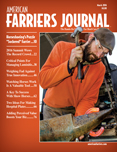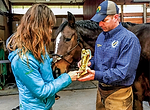Advertise Follow Us
American Farriers Journal

View Archived Issues
March 2016
Volume: 42
Edition: 2
American Farriers Journal is the “hands-on” magazine for professional farriers, equine veterinarians and horse care product and service buyers.
-
Table Of Contents
Table Of Contents
Shoeing for a LivingHorseshoeing’s Engineering Puzzle Charms Finger Lakes Farrier
Kirk Smith enjoys the challenge of balancing the horse’s system of levers and pulleysRead MoreAttendees Marvel At The “Strongest Summit To Date”
Footcare professionals enjoy 4 days of “priceless” educationRead MoreIHCS Photo Album
Another Year, Another Record Crowd To Improve Equine Footcare At The International Hoof-Care SummitRead MoreKey Points for Managing Laminitis
At a winter clinic, farrier Travis Burns reviews options available and the critical need to adhere to principles of treatmentRead MoreWhen is Something a True Innovation Vs. a Fad?
In the absence of hard scientific data, hoof-care professionals must turn to critical thinkingRead MoreSix Honored For Lifetime Contributions To Hoof Care
Three farriers and three veterinarians are inducted into Halls Of Fame for their life-long achievements in the footcare field at the International Hoof-Care SummitRead MoreFarriers Recognized As Future Footcare Leaders
Three farriers were honored at the 2016 International Hoof-Care Summit for making remarkable progress in their footcare careers just 3 years out of shoeing schoolRead MoreSuccess with Show Horses Demands Managing the Schedule
Managing the schedule of show horses requires careful planning and thorough communication with the footcare teamRead MoreGetting Better Results With Hospital Plates
Various insights on using hospital plates can help improve your chances for success when the need arisesRead MoreHygiene Considerations for the Farrier
In the already dangerous profession of farriery, pests and bacteria present additional threats to your well-beingRead MoreBoost Your Practice By Adding Perceived Value
Enhance your business and bottom line by providing services that cost you littleRead MoreImprove Your Tool Efficiency
Proper care and use will make your job easier and boost your bottom lineRead MoreSpotlight On Hoof Care: Clinic Stresses Forging And Modifying Shoes For Efficiency
English farrier Jon Atkinson walked attendees at the Well-Shod clinic in Amarillo, Texas, through his process for forging and modifying shoesRead MoreResearch Journal: March 2016
The information, ideas and opinions expressed are those of the author and do not necessarily represent those of the United States Department of Agriculture.Read More -
Featured Articles
Featured Articles
Shoeing for a LivingHorseshoeing’s Engineering Puzzle Charms Finger Lakes Farrier
Kirk Smith enjoys the challenge of balancing the horse’s system of levers and pulleysRead MoreIHCS Photo Album
Another Year, Another Record Crowd To Improve Equine Footcare At The International Hoof-Care SummitRead More - Digital Edition
-
Online Extras
Online Extras

















